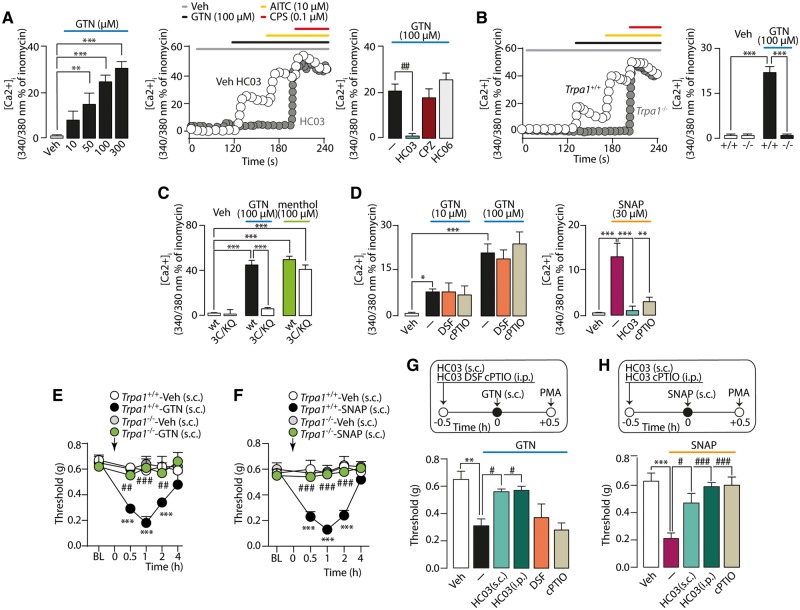Figure 2.
GTN-evoked PMA is mediated by NO. (A) Ca2+-response to GTN in mouse trigeminal ganglion neurons, which also respond to AITC or capsaicin (CPS), is attenuated by HC-030031 (HC03), but not by HC-067047 (HC06, TRPV4 antagonist) or capsazepine (CPZ, TRPV1 antagonist), and (B) abated by TRPA1 deletion. (C) Ca2+-response to GTN or menthol in HEK293-cells expressing wild-type (wt) or mutant (3C/K-Q) human TRPA1. (D) GTN-evoked Ca2+-response in trigeminal ganglion neurons is unaffected by disulfiram (DSF) or cPTIO while SNAP-evoked Ca2+-response is abated by cPTIO and HC03. Veh = the vehicle of GTN. Dash (‐) indicates combined vehicles of treatments. Error bars indicate mean ± SEM of n > 15 neurons or 50 cells (A–D). *P < 0.05, **P < 0.01, ***P < 0.001; one-way ANOVA with Bonferroni post hoc correction. (E and G) Local (10 µl s.c.) GTN (10 µg) evokes a time-dependent PMA that is abated in Trpa1−/− mice and by the pretreatment with local (s.c.) and systemic (i.p.) HC03 (100 µg and 100 mg/kg, respectively), but not with systemic DSF (100 mg/kg, i.p.) and cPTIO (0.6 mg/kg, i.p.). (F and H) Local (10 µl s.c.) SNAP (40 µg) induces a time-dependent PMA that is abated in Trpa1−/− mice and prevented by pretreatment with local (s.c.) and systemic (i.p.) HC03 (100 µg and 100 mg/kg, respectively) and systemic cPTIO (0.6 mg/kg, i.p.). BL = baseline mechanical threshold; Veh = the vehicle of GTN. Dash (‐) indicates combined vehicles of treatments. Arrows indicate time of drug administration. Error bars indicate mean ± SEM, 6–8 mice per group. **P < 0.01, ***P < 0.001 versus Trpa1+/+-Veh, vehicle and #P < 0.05, ##P < 0.01, ###P < 0.001 versus Trpa1+/+-GTN, GTN, Trpa1+/+-SNAP or SNA, one-way or two-way ANOVA with Bonferroni post hoc correction.

